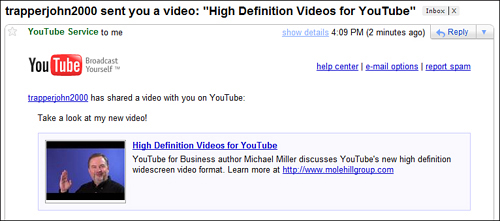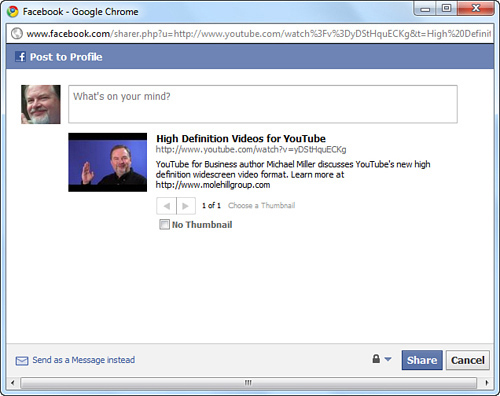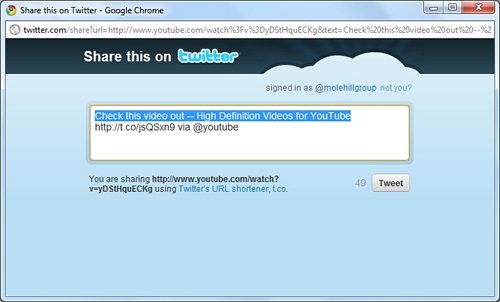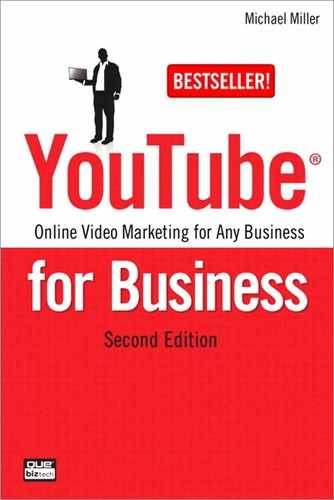20. Marketing Your YouTube Videos
The best-made video on YouTube is a dismal failure if no one watches it. How do you attract viewers to your YouTube videos, and thus create more potential customers for your business?
With millions of videos posted on the YouTube site, it’s tough to get your content noticed. Fortunately, there are many different ways you can promote your YouTube videos to attract new viewers. We discuss some of the more effective ones in this chapter.
Start with Great Content...
It goes without saying that all the promotion in the world won’t attract viewers to a video that doesn’t offer some distinct value. Viewers who follow the promotion to a lousy video simply click the Stop button when they begin to get bored, which happens soon enough. It all starts with great content, which can benefit from additional promotion.
Entertain, Inform, or Educate
The best YouTube videos offer something valuable to viewers. As I’ve noted earlier in this book, for a video to attract viewers, it has to do one of three things: entertain, inform, or educate the viewer. Here’s what I mean:
• Entertain—Most videos on YouTube strive to be entertaining. Whether you’re talking cute kittens, stupid human tricks, or wryly humorous vlog postings, the typical YouTube video contains some measure of entertainment value. This can also work for business videos; just as many of the most memorable television commercials are vastly entertaining (typically in a humorous vein), some of the most-viewed YouTube business videos are similarly entertaining. After all, people like to be entertained; if you can pull off such an entertaining video, it’s bound to draw viewers.
• Inform—One other thing that attracts viewers is information—in particular, information that is specifically relevant and useful to the viewer. I’m talking about the latest news, tailor-made for the target YouTube customer. When your company video has information that matters to particular YouTube viewers, those people will watch it.
• Educate—In a similar fashion, anytime you can help someone learn how to do something that they need to do, you attract eyeballs. Show mechanically inept viewers how to change the oil in their cars, or teach would-be chefs how to prepare a gourmet meal, and the help you provide gains praise. Step-by-step instruction attracts large numbers of viewers in today’s increasingly do-it-yourself world—as witnessed by the success of HGTV and the Food Network on cable television.
Pick one approach—entertainment, information, or education—and do it as best you can. Provide stellar content and you’re well on your way to upping your video view count.
Target Your Content
Here’s something else about the content of your videos: The more targeted it is, the faster it finds an audience. Yes, general videos would seem to appeal to a larger slice of the YouTube community. But general videos also get lost among the millions of other general videos; it’s tough to stand out in a crowd this large.
A much better approach is to target a particular slice of the community—a distinct customer base. As in any other form of advertising, the more narrowly you target the message, the more appeal you have to those targeted consumers.
In addition, when you niche-target your content, you can more easily promote it via YouTube’s community features, as well in the blogosphere and via social media such as Facebook and Twitter. When you narrowly identify the audience, it’s a snap to locate the groups, blogs, forums, and other outlets that target the same audience. A broadly focused video is much more difficult to promote; there are just too many channels to choose from, none of which is an exact hit. In fact, a general interest video might reach an audience altogether different from the one you really want to reach. Why waste your time targeting viewers who will never be your customers? You can more effectively and efficiently promote a narrowly targeted video via channels narrowly targeted in the same way.
Write a Compelling Title
The title of your video is crucial to attracting viewers. Not only is your title searched by YouTube when users submit queries, it’s also how most viewers determine what your video is about.
Yes, the full description is there to read, but most people skim rather than read—especially when they’re browsing through a page full of search results. So your title has to not only include the most important keywords or tags, but also convey the content of the video.
This means, of course, that you have to create a concise, descriptive, and compelling title. It’s copywriting at its finest, distilling the essence of what you have to offer in a very short line of copy; it takes a lot of work and no little experience to get right.
Pick the Best Thumbnail Image
Finally, remember what a typical YouTube search results page looks like—lots of video listings, each accompanied by a single thumbnail image, as shown in Figure 20.1. You need to attract viewers to your specific listing in the search results, which means presenting the most attractive and relevant thumbnail image possible.
Figure 20.1 Optimize your thumbnail image to stand out on search results pages.

YouTube lets you choose from three possible images to use as your video’s thumbnail image. It grabs the images from different points in your video. To choose a thumbnail image, go to your My Videos page and click the Edit button for the video you want to edit; when the next page appears, as shown in Figure 20.2, click the image you want to use as your thumbnail.
Figure 20.2 Choosing an image to use for your video thumbnail.

Tip
![]()
You don’t have to keep the same thumbnail image forever. Many marketers switch thumbnail images over the course of a video’s YouTube life, thus freshening the video’s appearance on search results pages.
The best thumbnails are clear, not blurry, and have a dominant subject—ideally a person’s face or a close-up of the product you’re selling. You can also stand out from the other listings with a brightly colored or high contrast image in your thumbnail—anything to make the thumbnail “pop” on the search results page.
Take Advantage of YouTube’s Community Features
One of the best places to promote your YouTube video is on YouTube itself. When you make the YouTube community aware of what you’re doing, other viewers do your promotion for you. Word-of-mouth marketing is alive and well on the YouTube site.
Sharing with Subscribers and Friends
Let’s start with those users who subscribe to your video channel, as well as those who added you to their Friends list. How do you let these positively predisposed viewers know that you have a new video to watch?
Dealing with subscribers is easy: YouTube does the work for you. Whenever you post a new video to the YouTube site, YouTube automatically sends an email to all of your channel’s subscribers informing them of the video. That’s easy.
More work is necessary to notify your friends of your latest video. Go to the video page, select the Share tab (under the video player), and click the Email button. This opens a new message window, shown in Figure 20.3. To send a message to all your contacts or friends, click the Add All Contacts or Add All Friends link in the scrolling list. Enter your message (something along the lines of “Check out our latest video”) in the Message box and click the Send button.
Figure 20.3 Sending an email to your YouTube friends.

Your friends receive an email message like the one in Figure 20.4. To view your video, all they have to do is click the video thumbnail or the link to the video; doing so takes them to the video page on the YouTube site, and you have one new viewer.
Figure 20.4 The email that your friends receive.

Guerilla Comments
Here’s a neat little promotional trick that might work for some businesses. It’s kind of a guerilla tactic, in that you piggyback on the success of someone else’s video.
Here’s how it works. You start by finding a video that’s similar to yours, in terms of subject matter or audience appeal. You want to find a video that has a much larger viewership than yours; this won’t work if you pick a lesser-viewed video.
The related video found and displayed, you now want to attach your video as a video comment to the more popular video. That’s right, you “comment” on the other video by displaying the video you want to promote. To do this, click within the comments box beneath the video then click the Attach a Video link, as shown in Figure 20.5. When the next page appears, as shown in Figure 20.6, click Choose a Video, select your video from the list and then click the Use the Selected Video button. That’s it; your video will now appear in the Video Comments section beneath the original video.
Figure 20.5 Adding a video comment to another video.

Figure 20.6 Selecting the video to use as your video comment.

As I said, this is definitely a guerilla marketing technique. It will get your video more exposure, but some YouTubers will be turned off by the blatant self-promotion. Attempt this one at your own risk.
Use Email Marketing
Of course, you’re not limited to promoting your videos just to the YouTube community. You can also promote your videos to anyone else on or off the Web.
One of the best ways to do this is to create an email mailing list on your main website, typically populated with email addresses provided by your customers. When you post a new video to YouTube, send a mailing to the entire list, letting your customers know all about the video and including a link to the video on YouTube. You might be surprised at how effective this simple technique can be.
Caution
![]()
Your email mailing list needs to be an opt-in list, or you might be accused of sending spam to your valued customers.
Reach Out to the Blogosphere
You can drive a lot of traffic to a YouTube video by getting that video mentioned on relevant blogs. It requires a bit of work to identify the blogs that might be interested in the content of your video, but then it’s a simple matter of sending out a press release (via email) that describes the video and includes a link to the YouTube video page. You might even want to include your video’s embed code in the introductory email, in case the blogger wants to actually embed your video in his blog.
Tip
![]()
If you’re so inclined, and have the time, you can reach out to individual bloggers via personal emails. This hands-on approach is much more effective than the blanket press release method.
In some instances, you might be able to pay bloggers to mention your videos. This pay per post (PPP) approach seems odious to some, but it’s increasingly common in the blogosphere.
When a blogger links to or embeds your video in his blog, you just created a new stream of viewers for your video. A certain percentage of these new viewers link back to your corporate website, just as a certain percentage subscribe to your channel to view future videos—thus becoming future potential customers.
Post to Other Web Forums
Along the same lines, you should work the various websites, forums, and message boards that target the same audience as your videos. Participate in appropriate discussions on these forums so that you can throw in a mention of or link to your video without appearing particularly mercenary.
After you become a familiar face on a given forum, it’s okay to start a new discussion when you have a new video to promote. Yes, this is a tedious and time-consuming approach, but it’s quite effective; you’re reaching out to some of the most influential members of the target community.
Caution
![]()
In most web communities, don’t even think about making a promotional post until you’ve established a presence in the community. Most communities are quite insular and uniformly dismissive of “carpetbaggers” operating purely in their own self-interest.
Work the Social Media
Another way to drive traffic to your videos is via a presence on Facebook, Twitter, and other social media sites. After you create your own personal or company page on these websites, you can then include YouTube videos as part of your status updates and tweets.
In fact, YouTube makes it easy to send videos to the most popular social media:
• MySpace
• Orkut
• hi5
• Bebo
• Google Buzz
• StumbleUpon
In addition, you can use this feature to send your videos directly to your Blogger-hosted blog.
To post a video to one of these social media sites, click the Share button under the video player on the video page and then click the appropriate social media button. This displays the list of compatible social media, as show in Figure 20.7.
Figure 20.7 Sharing a video via social media.

What happens next depends on the button you select. For example, when you click the Facebook button, you see the Post to Profile window shown in Figure 20.8. Enter a comment in the box and click the Share button, and your Facebook profile adds the video, as shown in Figure 20.9.
Figure 20.8 Posting a video to your Facebook profile.

Figure 20.9 A Facebook profile with a YouTube video added.

Note
![]()
Whichever social media site you select, you might be prompted to sign into that account with the appropriate user name and password.
If you click the Twitter button, you see the Share This on Twitter window, shown in Figure 20.10. Edit the text of the tweet as you like, then click the Tweet button. Twitter generates the tweet, linking to a short URL for the video you selected. Your Twitter followers can click this link to view the video.
Figure 20.10 Sharing a video via Twitter.

The takeaway here is that you should take advantage of all the features of the major social networking sites to promote your video with the widest possible network of online friends and acquaintances.
Tip
![]()
You should also promote your video on social bookmarking sites, such as Digg (www.digg.com) and Delicious (www.delicious.com). When you post a link to your video on these sites, it will be discovered by a wide range of other users—thus broadening the viewership of your video.
Run a Contest
Here’s a method mentioned elsewhere in the book, but worth repeating here. One interesting way to draw viewers to your videos is to run a contest of some sort. Some of the most successful contests directly involve viewers with the company’s videos by encouraging them to remix existing videos or create their own videos for the company or product.
Naturally, some customers will be attracted by any prizes you dole out, but most will visit your channel or group just to see what other YouTubers are posting; contest entries are bound to be entertaining in any number of ways. The most creative viewers will post entries to the contest—some of which might be good enough for you to use in other media. It’s a win-win for you because you get a spike in viewership, attract new customers, and reinforce your bonds with your existing customer base.
Promote Traditionally
While our focus is primarily on the Web, we mustn’t neglect more traditional forms of promotion—including old fashioned PR. This means issuing paper (and electronic) press releases, as well as picking up the phone (or firing up the email program) to hand-target individual publications and news outlets.
For example, if you have a video that has particular relevance to a particular industry, you can reach out to industry trade groups, publications, and the like with news about your video. Make sure you include a link to (or the URL for) the video in your press release, of course; any online news source can link directly from their coverage to the video on the YouTube site.
Likewise, if your video is of local or regional interest, reach out to your local news organizations—newspapers, television stations, radio stations, and their online arms. The best of all possible worlds comes when your video is not only mentioned on a local newscast, but also shown on air!
Upload to Other Video-Sharing Sites
You shouldn’t limit your videos to only YouTube. There are lots of other video sharing sites on the Web that, although smaller than the YouTube community, can help expand the reach of your videos. You already have your video produced, after all; why not distribute it as widely as you can?
Granted, none of the following sites has near the traffic as does YouTube, but they’re all free to use, so you might as well get to know them. These sites include the following:
• blip.tv (www.blip.tv)
• Dailymotio (www.dailymotion.com)
• Flixya (www.flixya.com)
• GUBA (www.guba.com)
• Metacafe (www.metacafe.com)
• Revver (www.revver.com)
• Veoh (www.veoh.com)
• Vimeo (www.vimeo.com)
• Yahoo! Video (video.yahoo.com)
Obviously, you should include your video on your own company website or blog. Your site has lots of visitors that might never visit the YouTube site; give them the opportunity to view your videos without leaving your official site!
Note
![]()
Learn more about posting your video on your company’s website in Chapter 18, “Incorporating YouTube Videos on Your Own Website.”
Advertise Your Video
This is a relatively new option for producers of YouTube videos. YouTube now offers the option of advertising your video on the YouTube site to YouTube viewers. YouTube calls the ads Promoted Videos, and they work just like Google AdWords or any other pay-per-click (PPC) advertising program. This is such a big deal that I’ve devoted a whole chapter to the topic; flip ahead to read about it.
The Big Picture
You can’t just upload a video to the YouTube site and expect a thousand views overnight. It takes a lot of hard work and creativity to attract viewers to your videos; it doesn’t happen by chance.
If you’re lucky, all your effort results in an upsurge of viewers for your video. At this point, success begins to beget success. That is, the more viewers you attract, the more they talk about and recommend your video, thus further increasing the view count. You need viewers to create more viewers.
Then, if you’re even luckier, your video’s view count is high enough to become one of YouTube’s top-rated videos. When this happens, your video appears on YouTube’s Videos tab, which displays the daily most-viewed videos. This is when your video hits the big time; with this type of prominent exposure, you get even more views than you did before. As I said, success begets success.
From there, the next logical step is to go viral. This happens when your video’s viewership expands beyond YouTube. Maybe a local television station picks up the video, or you get a mention on a major website, or CNN or MSNBC—or even David Letterman or The Daily Show—start showing the video on the home screen. If you’re lucky enough for this to happen, get ready for a wild ride. Your view count could easily hit the seven figure mark, and you could get more buzz than you ever thought possible.
This, of course, is what we all strive for: massive exposure with minimal cost and effort. But both you and I know that the effort wasn’t minimal; you have to work hard just to get basic exposure for your video, let alone go viral.
